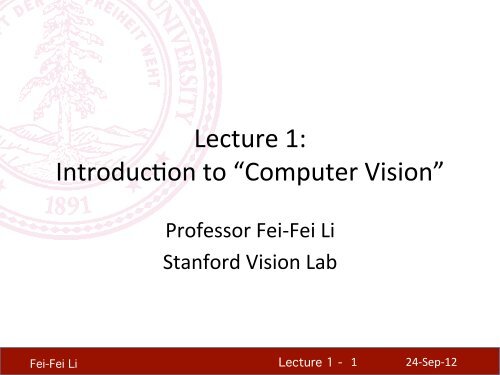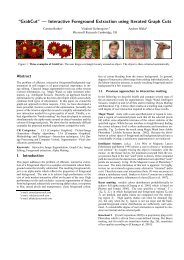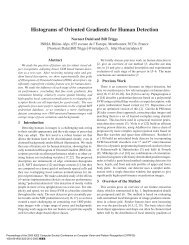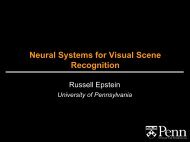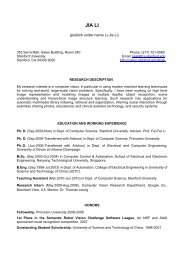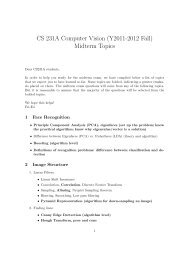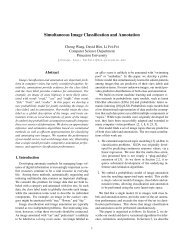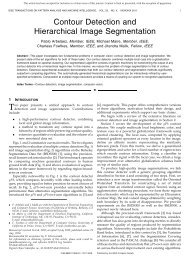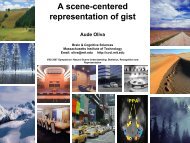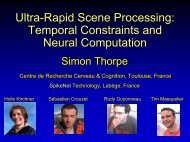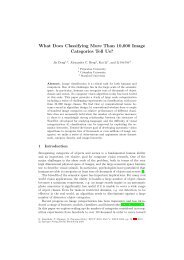Lecture 1 - Stanford Vision Lab; Prof. Fei-Fei Li
Lecture 1 - Stanford Vision Lab; Prof. Fei-Fei Li
Lecture 1 - Stanford Vision Lab; Prof. Fei-Fei Li
Create successful ePaper yourself
Turn your PDF publications into a flip-book with our unique Google optimized e-Paper software.
<strong>Fei</strong>-<strong>Fei</strong> <strong>Li</strong>!<br />
<strong>Lecture</strong> 1:<br />
Introduc.on to “Computer <strong>Vision</strong>”<br />
<strong>Prof</strong>essor <strong>Fei</strong>-‐<strong>Fei</strong> <strong>Li</strong><br />
<strong>Stanford</strong> <strong>Vision</strong> <strong>Lab</strong><br />
<strong>Lecture</strong> 1 - ! 1<br />
24-‐Sep-‐12
Welcome to CS231a: Computer <strong>Vision</strong><br />
<strong>Fei</strong>-<strong>Fei</strong> <strong>Li</strong>!<br />
<strong>Lecture</strong> 1 - ! 2<br />
24-‐Sep-‐12<br />
Slide adapted from Svetlana Lazebnik
<strong>Fei</strong>-<strong>Fei</strong> <strong>Li</strong>!<br />
Today’s agenda<br />
• Introduc.on to computer vision<br />
• Course overview<br />
<strong>Lecture</strong> 1 - ! 3<br />
24-‐Sep-‐12
<strong>Fei</strong>-<strong>Fei</strong> <strong>Li</strong>!<br />
Quiz?<br />
<strong>Lecture</strong> 1 - ! 4<br />
24-‐Sep-‐12
<strong>Fei</strong>-<strong>Fei</strong> <strong>Li</strong>!<br />
What about this?<br />
<strong>Lecture</strong> 1 - ! 5<br />
24-‐Sep-‐12
What is (computer) vision?<br />
Image (or video) Sensing device Interpreting device Interpretations<br />
<strong>Fei</strong>-<strong>Fei</strong> <strong>Li</strong>!<br />
<strong>Lecture</strong> 1 - ! 6<br />
garden, spring,<br />
bridge, water,<br />
trees, flower,<br />
green, etc.<br />
24-‐Sep-‐12
Engineering<br />
<strong>Fei</strong>-<strong>Fei</strong> <strong>Li</strong>!<br />
What is it related to?<br />
Speech<br />
Robo.cs<br />
Image<br />
processing<br />
Physics<br />
Biology<br />
Neuroscience<br />
Computer <strong>Vision</strong><br />
Cogni.ve<br />
sciences<br />
Machine learning<br />
Psychology<br />
Informa.on retrieval<br />
Maths<br />
<strong>Lecture</strong> 1 - ! 7<br />
graphics,algorithms,<br />
system,theory,…<br />
Computer<br />
Science<br />
24-‐Sep-‐12
<strong>Fei</strong>-<strong>Fei</strong> <strong>Li</strong>!<br />
The goal of computer vision<br />
• To bridge the gap between pixels and “meaning”<br />
What we see What a computer sees Source: S. Narasimhan<br />
<strong>Lecture</strong> 1 - ! 8<br />
24-‐Sep-‐12
What is (computer) vision?<br />
Image (or video) Sensing device Interpreting device Interpretations<br />
<strong>Fei</strong>-<strong>Fei</strong> <strong>Li</strong>!<br />
<strong>Lecture</strong> 1 - ! 9<br />
garden, spring,<br />
bridge, water,<br />
trees, flower,<br />
green, etc.<br />
24-‐Sep-‐12
<strong>Fei</strong>-<strong>Fei</strong> <strong>Li</strong>!<br />
1981: Nobel Prize in medicine<br />
Hubel & Wiesel<br />
<strong>Lecture</strong> 1 - ! 10<br />
24-‐Sep-‐12
Human vision is superbly efficient<br />
<strong>Fei</strong>-<strong>Fei</strong> <strong>Li</strong>!<br />
Potter, Biederman, etc. 1970s<br />
<strong>Lecture</strong> 1 - ! 11<br />
24-‐Sep-‐12
<strong>Fei</strong>-<strong>Fei</strong> <strong>Li</strong>!<br />
<strong>Lecture</strong> 1 - ! 12<br />
Thorpe, et al. Nature, 1996<br />
24-‐Sep-‐12
<strong>Fei</strong>-<strong>Fei</strong> <strong>Li</strong>!<br />
150 ms !!<br />
<strong>Lecture</strong> 1 - ! 13<br />
Thorpe, et al. Nature, 1996<br />
24-‐Sep-‐12
<strong>Fei</strong>-<strong>Fei</strong> <strong>Li</strong>!<br />
Change blindess<br />
<strong>Lecture</strong> 1 - ! 14<br />
Rensink, O’regan, Simon, etc.<br />
24-‐Sep-‐12
<strong>Fei</strong>-<strong>Fei</strong> <strong>Li</strong>!<br />
Change blindess<br />
<strong>Lecture</strong> 1 - ! 15<br />
Rensink, O’regan, Simon, etc.<br />
24-‐Sep-‐12
<strong>Fei</strong>-<strong>Fei</strong> <strong>Li</strong>!<br />
segmenta.on<br />
<strong>Lecture</strong> 1 - ! 16<br />
24-‐Sep-‐12
<strong>Fei</strong>-<strong>Fei</strong> <strong>Li</strong>!<br />
Percep.on<br />
<strong>Lecture</strong> 1 - ! 17<br />
24-‐Sep-‐12
<strong>Fei</strong>-<strong>Fei</strong> <strong>Li</strong>! <strong>Lecture</strong> 1 - ! 18<br />
24-‐Sep-‐12
<strong>Fei</strong>-<strong>Fei</strong> <strong>Li</strong>! <strong>Lecture</strong> 1 - ! 19<br />
24-‐Sep-‐12
What is (computer) vision?<br />
Image (or video) Sensing device Interpreting device Interpretations<br />
<strong>Fei</strong>-<strong>Fei</strong> <strong>Li</strong>!<br />
<strong>Lecture</strong> 1 - ! 20<br />
garden, spring,<br />
bridge, water,<br />
trees, flower,<br />
green, etc.<br />
24-‐Sep-‐12
<strong>Fei</strong>-<strong>Fei</strong> <strong>Li</strong>!<br />
The goal of computer vision<br />
• To bridge the gap between pixels and “meaning”<br />
What we see What a computer sees Source: S. Narasimhan<br />
<strong>Lecture</strong> 1 - ! 21<br />
24-‐Sep-‐12
<strong>Fei</strong>-<strong>Fei</strong> <strong>Li</strong>!<br />
Origins of computer vision:<br />
an MIT undergraduate summer project<br />
L. G. Roberts, Machine Percep,on of<br />
Three Dimensional Solids, Ph.D.<br />
thesis, MIT Department of Electrical<br />
Engineering, 1963.<br />
<strong>Lecture</strong> 1 - ! 22<br />
24-‐Sep-‐12
<strong>Fei</strong>-<strong>Fei</strong> <strong>Li</strong>!<br />
What kind of informa.on can<br />
we extract from an image?<br />
• Metric 3D informa.on<br />
• Seman.c informa.on<br />
<strong>Lecture</strong> 1 - ! 23<br />
24-‐Sep-‐12
<strong>Fei</strong>-<strong>Fei</strong> <strong>Li</strong>!<br />
<strong>Vision</strong> as measurement device<br />
Real-time stereo Structure from motion<br />
NASA Mars Rover<br />
Pollefeys et al.<br />
Reconstruction from<br />
Internet photo collections<br />
<strong>Lecture</strong> 1 - ! 24<br />
Goesele et al.<br />
24-‐Sep-‐12
<strong>Vision</strong> as a source of semantic information<br />
Slide credit: Kristen Grauman<br />
The Wicked<br />
Twister<br />
deck<br />
<strong>Fei</strong>-<strong>Fei</strong> <strong>Li</strong>!<br />
ride<br />
Lake Erie<br />
sky<br />
tree<br />
tree<br />
bench<br />
water<br />
Ferris<br />
wheel<br />
amusement park<br />
tree<br />
Cedar Point<br />
tree<br />
ride<br />
carousel<br />
12 E<br />
pedestrians<br />
<strong>Lecture</strong> 1 - ! 25<br />
ride<br />
people waiting in line<br />
people sitting on ride<br />
umbrellas<br />
Objects<br />
Activities<br />
Scenes<br />
Locations<br />
Text / writing<br />
Faces<br />
Gestures<br />
Motions<br />
Emotions…<br />
maxair<br />
24-‐Sep-‐12
<strong>Fei</strong>-<strong>Fei</strong> <strong>Li</strong>!<br />
Why study computer vision?<br />
• <strong>Vision</strong> is useful: Images and video are everywhere!<br />
Personal photo albums<br />
Surveillance and security<br />
Movies, news, sports<br />
Medical and scientific images<br />
<strong>Lecture</strong> 1 - ! 26<br />
24-‐Sep-‐12
<strong>Fei</strong>-<strong>Fei</strong> <strong>Li</strong>!<br />
Why study computer vision?<br />
• <strong>Vision</strong> is useful<br />
• <strong>Vision</strong> is interes.ng<br />
• <strong>Vision</strong> is difficult<br />
– Half of primate cerebral cortex is devoted to visual<br />
processing<br />
– Achieving human-‐level visual percep.on is probably<br />
“AI-‐complete”<br />
<strong>Lecture</strong> 1 - ! 27<br />
24-‐Sep-‐12
Why is computer vision difficult?<br />
<strong>Fei</strong>-<strong>Fei</strong> <strong>Li</strong>!<br />
<strong>Lecture</strong> 1 - ! 28<br />
24-‐Sep-‐12
Challenges: viewpoint variation<br />
Michelangelo 1475-1564<br />
<strong>Fei</strong>-<strong>Fei</strong> <strong>Li</strong>!<br />
<strong>Lecture</strong> 1 - ! 29<br />
slide credit: <strong>Fei</strong>-<strong>Fei</strong>, Fergus & Torralba<br />
24-‐Sep-‐12
Challenges: illumination<br />
<strong>Fei</strong>-<strong>Fei</strong> <strong>Li</strong>!<br />
<strong>Lecture</strong> 1 - ! 30<br />
image credit: J. Koenderink<br />
24-‐Sep-‐12
Challenges: scale<br />
<strong>Fei</strong>-<strong>Fei</strong> <strong>Li</strong>!<br />
<strong>Lecture</strong> 1 - ! 31<br />
24-‐Sep-‐12<br />
slide credit: <strong>Fei</strong>-<strong>Fei</strong>, Fergus & Torralba
Challenges: deformation<br />
Xu, Beihong 1943<br />
<strong>Fei</strong>-<strong>Fei</strong> <strong>Li</strong>!<br />
<strong>Lecture</strong> 1 - ! 32<br />
slide credit: <strong>Fei</strong>-<strong>Fei</strong>, Fergus & Torralba<br />
24-‐Sep-‐12
Challenges: occlusion<br />
<strong>Fei</strong>-<strong>Fei</strong> <strong>Li</strong>!<br />
Magritte, 1957<br />
<strong>Lecture</strong> 1 - ! 33<br />
24-‐Sep-‐12<br />
slide credit: <strong>Fei</strong>-<strong>Fei</strong>, Fergus & Torralba
Challenges: background clutter<br />
<strong>Fei</strong>-<strong>Fei</strong> <strong>Li</strong>!<br />
<strong>Lecture</strong> 1 - ! 34<br />
24-‐Sep-‐12<br />
slide credit: Svetlana Lazebnik
Challenges: Motion<br />
<strong>Fei</strong>-<strong>Fei</strong> <strong>Li</strong>!<br />
<strong>Lecture</strong> 1 - ! 35<br />
24-‐Sep-‐12<br />
slide credit: Svetlana Lazebnik
Challenges: object intra-‐class varia.on<br />
<strong>Fei</strong>-<strong>Fei</strong> <strong>Li</strong>!<br />
<strong>Lecture</strong> 1 - ! 36<br />
24-‐Sep-‐12<br />
slide credit: <strong>Fei</strong>-<strong>Fei</strong>, Fergus & Torralba
<strong>Fei</strong>-<strong>Fei</strong> <strong>Li</strong>!<br />
Challenges: local ambiguity<br />
<strong>Lecture</strong> 1 - ! 37<br />
24-‐Sep-‐12<br />
slide credit: <strong>Fei</strong>-<strong>Fei</strong>, Fergus & Torralba
Challenges or opportuni.es?<br />
• Images are confusing, but they also reveal the<br />
structure of the world through numerous cues<br />
• Our job is to interpret the cues!<br />
<strong>Fei</strong>-<strong>Fei</strong> <strong>Li</strong>!<br />
<strong>Lecture</strong> 1 - ! 38<br />
24-‐Sep-‐12<br />
Image source: J. Koenderink
<strong>Fei</strong>-<strong>Fei</strong> <strong>Li</strong>!<br />
Depth cues: <strong>Li</strong>near perspec.ve<br />
<strong>Lecture</strong> 1 - ! 39<br />
24-‐Sep-‐12<br />
slide credit: Svetlana Lazebnik
<strong>Fei</strong>-<strong>Fei</strong> <strong>Li</strong>!<br />
Depth cues: Aerial perspec.ve<br />
<strong>Lecture</strong> 1 - ! 40<br />
24-‐Sep-‐12<br />
slide credit: Svetlana Lazebnik
<strong>Fei</strong>-<strong>Fei</strong> <strong>Li</strong>!<br />
Depth ordering cues: Occlusion<br />
<strong>Lecture</strong> 1 - ! 41<br />
24-‐Sep-‐12<br />
Source: J. Koenderink
<strong>Fei</strong>-<strong>Fei</strong> <strong>Li</strong>!<br />
Shape cues: Texture gradient<br />
<strong>Lecture</strong> 1 - ! 42<br />
24-‐Sep-‐12<br />
slide credit: Svetlana Lazebnik
<strong>Fei</strong>-<strong>Fei</strong> <strong>Li</strong>!<br />
Shape and ligh.ng cues: Shading<br />
<strong>Lecture</strong> 1 - ! 43<br />
24-‐Sep-‐12<br />
Source: J. Koenderink
<strong>Fei</strong>-<strong>Fei</strong> <strong>Li</strong>!<br />
Posi.on and ligh.ng cues: Cast shadows<br />
<strong>Lecture</strong> 1 - ! 44<br />
24-‐Sep-‐12<br />
Source: J. Koenderink
Grouping cues: Similarity (color, texture, proximity)<br />
<strong>Fei</strong>-<strong>Fei</strong> <strong>Li</strong>!<br />
<strong>Lecture</strong> 1 - ! 45<br />
24-‐Sep-‐12<br />
slide credit: Svetlana Lazebnik
<strong>Fei</strong>-<strong>Fei</strong> <strong>Li</strong>!<br />
Grouping cues: “Common fate”<br />
<strong>Lecture</strong> 1 - ! 46<br />
24-‐Sep-‐12<br />
Image credit: Arthus-Bertrand (via F. Durand)
<strong>Fei</strong>-<strong>Fei</strong> <strong>Li</strong>!<br />
Bogom line<br />
• Percep.on is an inherently ambiguous problem<br />
– Many different 3D scenes could have given rise to a par.cular 2D picture<br />
<strong>Lecture</strong> 1 - ! 47<br />
24-‐Sep-‐12
Bogom line<br />
• Percep.on is an inherently ambiguous problem<br />
– Many different 3D scenes could have given rise to a par.cular 2D<br />
picture<br />
• Possible solu.ons<br />
– Bring in more constraints (more images)<br />
– Use prior knowledge about the structure of the world<br />
• Need a combina.on of different methods<br />
<strong>Fei</strong>-<strong>Fei</strong> <strong>Li</strong>!<br />
<strong>Lecture</strong> 1 - ! 48<br />
24-‐Sep-‐12
Computer <strong>Vision</strong> in the Real World<br />
<strong>Fei</strong>-<strong>Fei</strong> <strong>Li</strong>!<br />
<strong>Lecture</strong> 1 - ! 49<br />
24-‐Sep-‐12
Special effects: shape and mo.on capture<br />
<strong>Fei</strong>-<strong>Fei</strong> <strong>Li</strong>!<br />
<strong>Lecture</strong> 1 - ! 50<br />
24-‐Sep-‐12<br />
Source: S. Seitz
<strong>Fei</strong>-<strong>Fei</strong> <strong>Li</strong>!<br />
3D urban modeling<br />
Bing maps, Google Streetview<br />
<strong>Lecture</strong> 1 - ! 51<br />
Source: S. Seitz<br />
24-‐Sep-‐12
3D urban modeling: Microsoj Photosynth<br />
<strong>Fei</strong>-<strong>Fei</strong> <strong>Li</strong>!<br />
hgp://labs.live.com/photosynth/ Source: S. Seitz<br />
<strong>Lecture</strong> 1 - ! 52<br />
24-‐Sep-‐12
<strong>Fei</strong>-<strong>Fei</strong> <strong>Li</strong>!<br />
Face detec.on<br />
• Many new digital cameras now detect faces<br />
– Canon, Sony, Fuji, …<br />
<strong>Lecture</strong> 1 - ! 53<br />
Source: S. Seitz<br />
24-‐Sep-‐12
<strong>Fei</strong>-<strong>Fei</strong> <strong>Li</strong>!<br />
Smile detec.on<br />
Sony Cyber-shot® T70 Digital Still Camera Source: S. Seitz<br />
<strong>Lecture</strong> 1 - ! 54<br />
24-‐Sep-‐12
<strong>Fei</strong>-<strong>Fei</strong> <strong>Li</strong>!<br />
Face recogni.on: Apple iPhoto sojware<br />
hgp://www.apple.com/ilife/iphoto/<br />
<strong>Lecture</strong> 1 - ! 55<br />
24-‐Sep-‐12
<strong>Fei</strong>-<strong>Fei</strong> <strong>Li</strong>!<br />
Biometrics<br />
How the Afghan Girl was Iden.fied by Her Iris Pagerns<br />
<strong>Lecture</strong> 1 - ! 56<br />
Source: S. Seitz<br />
24-‐Sep-‐12
<strong>Fei</strong>-<strong>Fei</strong> <strong>Li</strong>!<br />
Fingerprint scanners on<br />
many new laptops,<br />
other devices<br />
Biometrics<br />
Face recogni.on systems now beginning<br />
to appear more widely<br />
hgp://www.sensiblevision.com/<br />
<strong>Lecture</strong> 1 - ! 57<br />
Source: S. Seitz<br />
24-‐Sep-‐12
Op.cal character recogni.on (OCR)<br />
Technology to convert scanned docs to text<br />
• If you have a scanner, it probably came with OCR sojware<br />
<strong>Fei</strong>-<strong>Fei</strong> <strong>Li</strong>!<br />
Digit recognition, AT&T labs<br />
<strong>Li</strong>cense plate readers<br />
http://en.wikipedia.org/wiki/Automatic_number_plate_recognition<br />
<strong>Lecture</strong> 1 - ! 58<br />
Source: S. Seitz<br />
24-‐Sep-‐12
<strong>Fei</strong>-<strong>Fei</strong> <strong>Li</strong>!<br />
Toys and Robots<br />
<strong>Lecture</strong> 1 - !
Mobile visual search: iPhone Apps<br />
<strong>Fei</strong>-<strong>Fei</strong> <strong>Li</strong>!<br />
<strong>Lecture</strong> 1 - ! 61<br />
24-‐Sep-‐12
<strong>Fei</strong>-<strong>Fei</strong> <strong>Li</strong>!<br />
Automo.ve safety<br />
• Mobileye: <strong>Vision</strong> systems in high-‐end BMW, GM, Volvo models<br />
– “In mid 2010 Mobileye will launch a world's first applica.on of full<br />
emergency braking for collision mi.ga.on for pedestrians where<br />
vision is the key technology for detec.ng pedestrians.”<br />
<strong>Lecture</strong> 1 - ! 62<br />
Source: A. Shashua, S. Seitz<br />
24-‐Sep-‐12
<strong>Fei</strong>-<strong>Fei</strong> <strong>Li</strong>!<br />
<strong>Vision</strong> in supermarkets<br />
LaneHawk by EvolutionRobotics<br />
“A smart camera is flush-mounted in the checkout lane, continuously watching for items.<br />
When an item is detected and recognized, the cashier verifies the quantity of items that<br />
were found under the basket, and continues to close the transaction. The item can remain<br />
under the basket, and with LaneHawk, you are assured to get paid for it… “ Source: S. Seitz<br />
<strong>Lecture</strong> 1 - ! 63<br />
24-‐Sep-‐12
<strong>Vision</strong>-‐based interac.on (and games)<br />
Microsoft’s Kinect<br />
<strong>Fei</strong>-<strong>Fei</strong> <strong>Li</strong>!<br />
Assistive technologies<br />
<strong>Lecture</strong> 1 - ! 64<br />
Sony EyeToy<br />
Source: S. Seitz<br />
24-‐Sep-‐12
<strong>Vision</strong> for robo.cs, space explora.on<br />
NASA'S Mars Explora.on Rover Spirit captured this westward view from atop<br />
a low plateau where Spirit spent the closing months of 2007.<br />
<strong>Vision</strong> systems (JPL) used for several tasks<br />
• Panorama s.tching<br />
<strong>Fei</strong>-<strong>Fei</strong> <strong>Li</strong>!<br />
• 3D terrain modeling<br />
• Obstacle detec.on, posi.on tracking<br />
• For more, read “Computer <strong>Vision</strong> on Mars” by Maghies et al.<br />
<strong>Lecture</strong> 1 - ! 65<br />
24-‐Sep-‐12<br />
Source: S. Seitz
<strong>Fei</strong>-<strong>Fei</strong> <strong>Li</strong>!<br />
The computer vision industry<br />
• A list of companies here:<br />
hgp://www.cs.ubc.ca/spider/lowe/vision.html<br />
<strong>Lecture</strong> 1 - ! 66<br />
24-‐Sep-‐12
<strong>Fei</strong>-<strong>Fei</strong> <strong>Li</strong>!<br />
Today’s agenda<br />
• Introduc.on to computer vision<br />
• Course overview<br />
<strong>Lecture</strong> 1 - ! 67<br />
24-‐Sep-‐12
<strong>Fei</strong>-<strong>Fei</strong> <strong>Li</strong>!<br />
Overall philosophy<br />
• Breadth<br />
– Computer vision is a huge field<br />
– It can impact every aspect of life and society<br />
– It will drive the next informa.on and AI revolu.on<br />
– Pixels are everywhere in our lives and cyber space<br />
– <strong>Lecture</strong>s are high-‐level, meant to be informa.ve, and covers many topics<br />
– Lots of links to references. Know where to look for references<br />
– Speak our “language”<br />
• Depth<br />
– Computer vision is a highly technical field, i.e. know your math!<br />
– Homework meant to be challenging, both theore.cal ques.ons and<br />
programming exercises<br />
– Master bread-‐and-‐buger techniques: face recogni.on, corners, lines, features,<br />
op.cal flows, clustering and segmenta.on, basic object recogni.on<br />
techniques<br />
– Course projects are your hands-‐on experience in computer vision systems and<br />
research<br />
<strong>Lecture</strong> 1 - ! 68<br />
24-‐Sep-‐12
<strong>Fei</strong>-<strong>Fei</strong> <strong>Li</strong>!<br />
Contac.ng instructor and TAs<br />
• ALL EMAIL CORRESPONDENCES TO ANYONE OF US:<br />
– cs231a-‐aut1213-‐staff@lists.stanford.edu<br />
• <strong>Prof</strong>essor: <strong>Fei</strong>-‐<strong>Fei</strong> <strong>Li</strong><br />
– Office hour: Tues 3:30-‐4:30pm<br />
• Jon Krause, Ph.D, CS<br />
– Office hour: Mon 4:30-‐5:30pm<br />
• Vignesh Ramanathan, Ph.D, EE<br />
– Office hour: Wed 3:00-‐4:00pm<br />
• Jinchao Ye, master, CS<br />
– Office hour: TBD<br />
• Zixuan Wang, master, CS<br />
– Office hour: Fri 3:00-‐4:00pm<br />
<strong>Lecture</strong> 1 - ! 69<br />
24-‐Sep-‐12
• Go to website…<br />
<strong>Fei</strong>-<strong>Fei</strong> <strong>Li</strong>!<br />
Syllabus<br />
<strong>Lecture</strong> 1 - ! 70<br />
24-‐Sep-‐12
<strong>Fei</strong>-<strong>Fei</strong> <strong>Li</strong>!<br />
Course Project: overview<br />
• 40% of your grade<br />
• Form your team:<br />
– either 2 people or 1 person<br />
– but the quality is judged regardless of the number of<br />
people on the team<br />
– be nice to your partner: do you plan to drop the<br />
course?<br />
• No late days<br />
• Mandatory agendance on Dec 6 for all non-‐SCPD<br />
students<br />
<strong>Lecture</strong> 1 - ! 71<br />
24-‐Sep-‐12
<strong>Fei</strong>-<strong>Fei</strong> <strong>Li</strong>!<br />
Course Project: overview (con.nued)<br />
• Start immediately<br />
• Some important dates:<br />
– Oct 16<br />
• Finalize team<br />
• Project proposal due for “open project” teams<br />
– Nov 6<br />
• Milestone due (2-‐3 pages)<br />
– Dec 3<br />
• Final codes due<br />
– Dec 4<br />
• Final writeup due<br />
– Dec 6<br />
• Presenta.on<br />
<strong>Lecture</strong> 1 - ! 72<br />
24-‐Sep-‐12
<strong>Fei</strong>-<strong>Fei</strong> <strong>Li</strong>!<br />
Course Project Op.on #1:<br />
the Finding Mii Challenge<br />
<strong>Lecture</strong> 1 - ! 73<br />
24-‐Sep-‐12
• Original research ideas encouraged<br />
• Useful datasets:<br />
– ImageNet (www.image-‐net.org)<br />
– PASCAL<br />
• Need <strong>Fei</strong>-‐<strong>Fei</strong>’s approval<br />
– Email is the best way<br />
– Do it BEFORE Oct 16 (proposal submission<br />
deadline)<br />
<strong>Fei</strong>-<strong>Fei</strong> <strong>Li</strong>!<br />
Course Project Op.on #2:<br />
Open Project<br />
<strong>Lecture</strong> 1 - ! 74<br />
24-‐Sep-‐12
<strong>Fei</strong>-<strong>Fei</strong> <strong>Li</strong>!<br />
Grading policy<br />
• Problem Sets: 40%<br />
– We have 5 problem sets<br />
– Homework 0: very important! (more details…)<br />
– Late policy<br />
• 5 free late days – use them in your ways<br />
• Ajerwards, 25% off per day late<br />
• Not accepted ajer 3 late days per PS<br />
– Collabora.on policy<br />
• Read the student code book, understand what is ‘collabora.on’<br />
and what is ‘academic infrac.on’<br />
• Midterm Exam: 20%<br />
– In class: Tues, Oct 30<br />
<strong>Lecture</strong> 1 - ! 75<br />
24-‐Sep-‐12
<strong>Fei</strong>-<strong>Fei</strong> <strong>Li</strong>!<br />
Grading policy<br />
• Course project: 40%<br />
– presenta.on: 5%<br />
– write-‐up: 10%<br />
• clarity, structure, language, references: 3%<br />
• background literature survey, good understanding of the problem:<br />
3%<br />
• good insights and discussions of methodology, analysis, results,<br />
etc.: 4%<br />
– technical: 15%<br />
• correctness: 5%<br />
• depth: 5%<br />
• innova.on: 5%<br />
– evalua.on and results: 10%<br />
• sound evalua.on metric: 3%<br />
• thoroughness in analysis and experimenta.on: 3%<br />
• A word about ‘the curve’<br />
<strong>Lecture</strong> 1 - ! 76<br />
24-‐Sep-‐12


